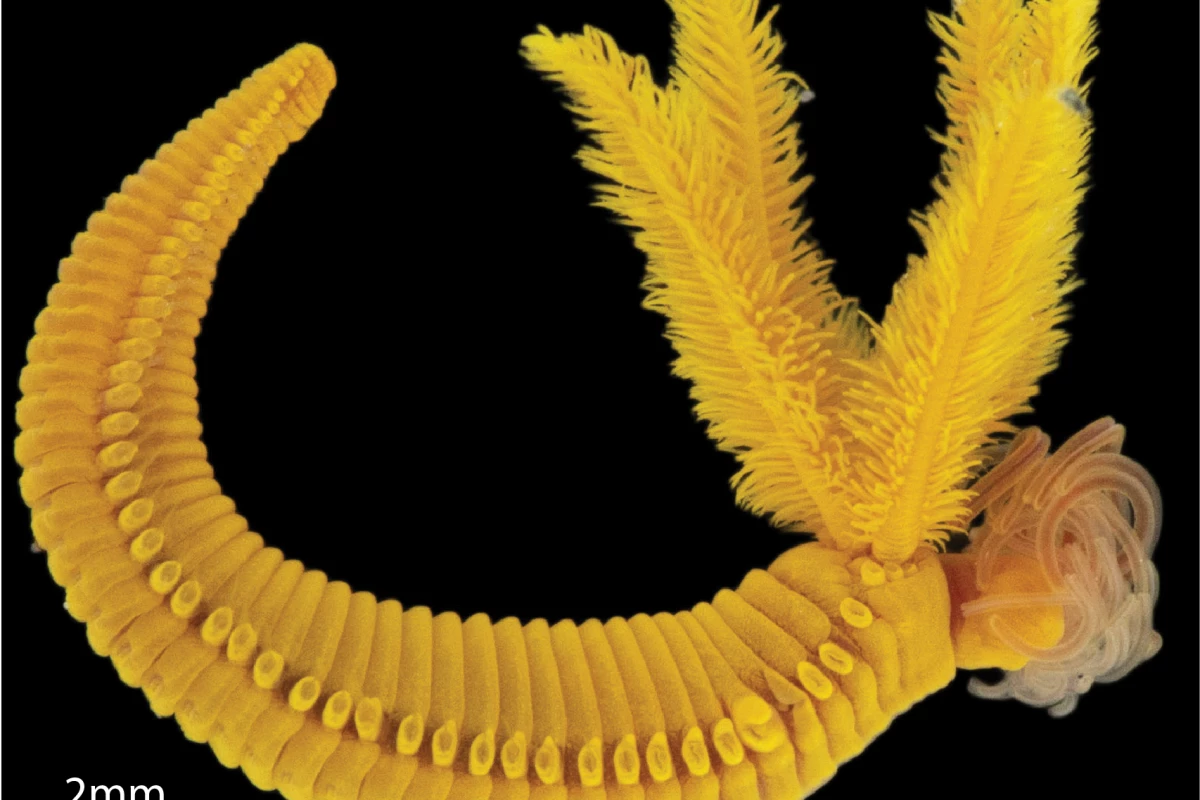At the bottom of the ocean, where metal-rich hydrothermal vents exhale poison, a bright yellow worm has mastered an impossible art: turning lethal elements into armor. Meet Paralvinella hessleri, the deep-sea super-worm that detoxifies arsenic by turning it into crystal.
A new study published in PLOS Biology has uncovered evolution’s wildest chemistry experiment yet. Scientist Chaolun Li at the Institute of Oceanology in China, and his colleagues identified a unique type of sea worm, dubbed Paralvinella hessleri. The sea worm thrives in deep-sea hydrothermal vents in Japan’s Okinawa Trough, where temperatures can reach up to 300 °C (572 °F).
What makes this environment so fascinating isn’t just the extreme heat, but the metal-rich chemical soup that constantly burbles into surrounding waters.
In this toxic blend, where arsenic reaches deadly concentrations, Li and his team found that the worm has a unique method of crystallizing arsenic inside its own cells to neutralize toxicity. But how, exactly, does this bright yellow vent-dweller pull off this super-worm feat?
Biomineralization – How it Works
Li and his team discovered that the worm’s vivid yellow hue comes from microscopic granules packed into the epithelial cells that line its skin and gills. Those granules are loaded with arsenic, which makes up roughly one percent of its total body weight, and almost entirely in its most toxic form, arsenite. As these fluids cool, minerals crystallize and coat nearby surfaces, creating a dynamic habitat where chemistry constantly shifts.
Instead of letting the element wreak havoc, the worm shuttles arsenic into membrane-bound vacuoles, where it reacts with another vent toxin: dissolved hydrogen sulfide. Inside this deep-sea chemistry lab, the two poisons lock together into solid orpiment (As₂S₃) crystals, transforming them from lethal threats into inert, glittering deposits.
“I was stunned by what I saw on the ROV monitor – the bright yellow Paralvinella hessleri worms were unlike anything I had ever seen, standing out vividly against the white biofilm and dark hydrothermal vent landscape,” said co-author Dr. Hao Wang. “It was hard to believe that any animal could survive, let alone thrive, in such an extreme and toxic environment.”
The Molecular Helpers
But turning poison into crystal takes next-level super-worm coordination. Proteomic analysis showed that the membranes around those yellow granules are bristling with transporter proteins, including an overachieving multidrug-resistance-associated protein.
Its job appears to be shuttling arsenic directly into the vacuoles where mineralization happens. Sulfide, meanwhile, takes a different route. Evidence suggests the worm’s specialized hemoglobin ferries sulfide to the same vacuoles, delivering the final ingredient for the worm’s deep-sea alchemy.
Proof from the Chemistry
To verify where the sulfide comes from, the team measured sulfur isotopes in P. hessleri and other animals living at different distances from the vents. The worm’s signature matched vent H₂S gas exactly, confirming it draws sulfide straight from the toxic fluids erupting beneath it. Rather than fighting the toxins, the worm recruits them, turning the vents’ fury into its personal bodyguard.
This discovery rewrites the rulebook for life in extreme environments. Instead of evading toxins or relying on symbiotic microbes for protection, P. hessleri transforms them into structural material, locking poison into mineral form. The researchers suggest this strategy may be shared by other deep-vent species, modulated by the local chemistry of their relevant habitats.
And with only one other animal known to mineralize sulfide, the scaly-foot snail, the find expands the short list of species capable of such biochemical feats. Yet P. hessleri remains largely a mystery. It lives beyond the reach of laboratories, accessible only by deep-sea submersibles, making it difficult to fully characterize its mineralization process.
To resolve those unknowns, the team’s next step is to pinpoint how the worm’s sulfide armor forms at the molecular level. Their work could reveal the structural choreography behind this transformation and broaden our understanding of the biochemical limits of life – where survival depends on mastering the very elements of its environment.
“Our hope is that this model will encourage scientists to rethink how marine invertebrates interact with and possibly harness toxic elements in their environment,” the authors write.
This study was published in PLOS Biology.
Source: PLOS via Science Daily





